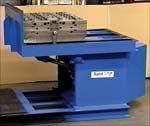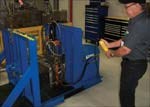A Shortcut for Improving Toolroom Efficiency
Developments, strategies, processes and technologies are available to help ensure an efficient toolroom.
There's nothing wrong with hard work, but when it costs you time, it's probably costing your company money. Toolrooms have always been known for the skills of their personnel. Unfortunately these highly skilled, and often highly paid personnel have spent large portions of their time performing either laborious or menial tasks. Many toolrooms have found shortcuts that are not only improving the efficiency of the toolroom, but also are im-proving morale by making life in the toolrooms more pleasant.
One such development is a die separator. This ingenious device opens and closes molds almost instantly. The machine has a flat bottom bay with two platens. One platen is movable and the other is stationary, just as in a production press.
Here's the difference, there is no manual clamping of a mold. The platens have powerful electromagnets embedded in them. The mold is dropped into the bay, the platens are closed and the magnets are turned on. When the platen is reversed, the mold is opened instantly. The platens and the level floor keep the leader pins and bushings aligned, eliminating jammed molds.
Opening and closing molds is so easy that Eric Gehrke of Worldwide Distributors, a Lester Prairie Minnesota custom molder says, "We clean all of our molds in a separator!"
A separator opens and closes molds in remarkably quick time. However, this device doesn't stop there. The mold half that is left on the front, stationary platen is now ready for tipping. By simply pulling a lever, the machine's hydraulics quickly tip this half of the mold into a horizontal position. Reversing this procedure tips down and ultimately closes the mold. If the mold being worked on was a three-part mold, the crane would have remained attached to the floating section and removed after the mold had been opened to full daylight. External rails would have been removed before opening and internal rails would be pulled until they cleared the floating section. Finishing out the handiness of the die separator is the core pull feature, which allows the machine's hydraulics to be used to work cores on a mold while it is in the die separator.
"I love our mold separator," says Ray Thompson of Intralox, a producer of proprietary conveyor belts in Harahan, LA, "not only does this eliminate manual labor and make our toolroom a much better place to work, but we've caught up on our PMs."
Related Content
-
Three 3D Scanner Investment Considerations
Mold builders taking advantage of laser and software advancements for portable 3D measurement tools can reduce inspection and measurement times.
-
Technology Roundup: New/Improved Technologies You Don't Want to Miss
With all the technology joining the market, moldmaking is a versatile, ever-evolving industry. As such, this technology roundup has no specific theme — it features a variety of products for applications and solutions across the industry.
-
Breaking Down 3D Scanning in Moldmaking
Identifying 3D scanning requirements and implementing the appropriate technology.
















.jpg;maxWidth=300;quality=90)
